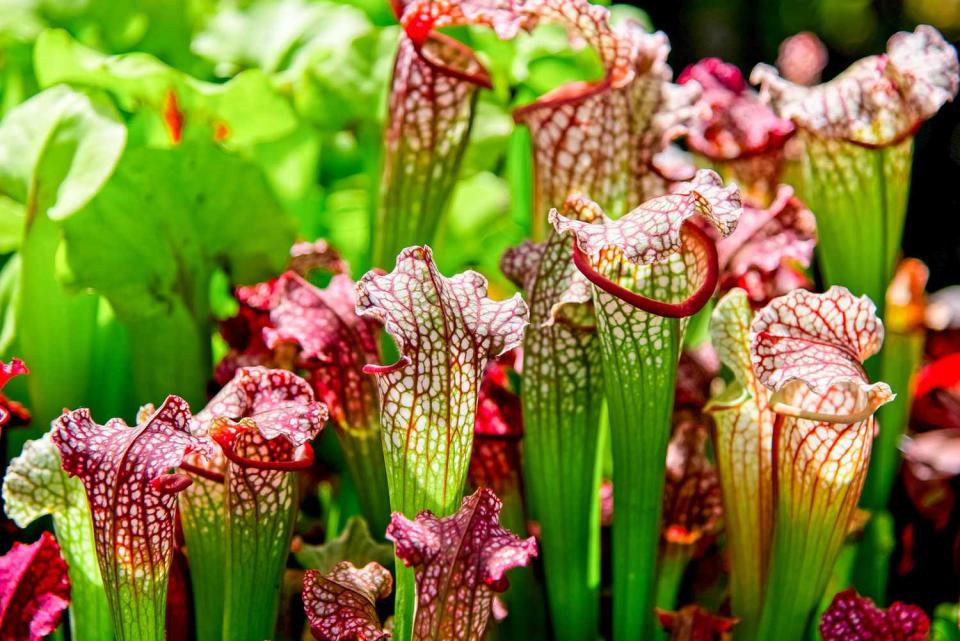How to Grow and Care for Pitcher Plants, a Carnivorous Variety That Will Help Control Pests
TABLE OF CONTENTS
On This Page
Main Varieties
Outdoor Care
Indoor Care
When to Repot
Propagating Tips
Common Problems
If you're looking for a unique new houseplant or a conversation piece for your indoor garden, you might want to consider pitcher plants. These carnivorous beauties stand out among the rest of your typical indoor greenery thanks to the unusual "pitchers" that hang from their center or shoot up from the stems. Intriguing aesthetics aside, this variety's best quality might be their ability to keep indoor pests in check. Learn how to grow them inside and out with help from our garden experts.
Related: 8 Houseplants That Thrive in Low Light

GETTY IMAGES
Pitcher Plant Varieties
There are many species of pitcher plants, but the two most common are Nepenthes and Sarracenia, according to Lindsay Pangborn, Bloomscape's plant expert. "The Nepenthes pitcher plant is one of the more uniquely structured ones, with a freeform, arching habit," she says (see above). This plant can be identified by the large, colorful pitchers that form on the ends of its leaves. "These traps dangle gracefully, adding a nice pop of color that attracts insects," she says, adding that the variety is an excellent choice for families with curious children (since it's so easy to view what is happening in the large, wide pitchers!).
The Sarracenia pitcher plant is another carnivorous variety that is often called "trumpet pitcher," thanks to its tall, slender tubes that resemble the body of the instrument, says Pangborn. "Brightly colored pitchers range in color and pattern, including shades of red and purple along with interesting netted and speckled patterns," she says.
How to Plant Pitcher Plants Outside
If you live in USDA Hardiness zones 7 and above, you can safely add a pitcher plant to your outdoor landscape. "Pitcher plants love to be potted near other plants that provide extra nitrogen and moisture, such as ferns, begonias, and aroids," says Zeeshan Haider, the CEO of Greenry Enthusiast. "However, it is important not to pot pitcher plants near other carnivorous plants, as they can be more competitive with the same resources and attract more insects which, while providing food, can also be harmful to the other plants."

GETTY IMAGES
How to Care for Pitcher Plants Indoors
Pitcher plants also make great houseplants, but they require some maintenance in the light and water department.
Light
Pitcher plants require long periods of bright light to survive, says Pangborn. "It's best to place them outdoors in full sun where they can receive at least six hours of direct sunlight," she says. "They can be grown indoors on a sunny windowsill or with a grow light."
Soil and Water
These carnivores need a lot of moisture, which is why Pangborn says it's so important to stay on top of your watering schedule. "Water your plant when the soil volume is 25 percent dry and avoid missing a watering, as pitcher plants are not tolerant of drought conditions."
Pruning
The good news is that pitcher plants typically do not need to be trimmed, except in the case where leaves or pitchers are beginning to brown due to lack of soil moisture or humidity. "If more than 50 percent of the surface is brown, it's best to remove it from the plant," Pangborn adds.
Fertilizer
Because they get most of their nutritional needs from the insects they trap and digest, pitcher plants shouldn't be given any fertilizers, says Pangborn. "At times, the fertilizer may actually harm this plant since it is not accustomed to living in nutrient-rich soil," she says.
Related: How to Repot a Houseplant the Right Way
When to Repot Pitcher Plants
When your pitcher plant has outgrown its current pot, it's time to size up. "You'll know it's time when you can see roots coming out of the drainage holes at the bottom of the pot, or when you can easily lift the plant out of its pot by grasping the stem," Haider says.

Gleti / GETTY IMAGES
How to Propagate Pitcher Plants
Depending on the variety, you can propagate your pitcher plants, creating babies to raise or give away.
Sarracenia
"Sarracenia pitcher plants are best propagated by a method called division, which involves cutting off a portion of an established plant," Pangborn says. "In an established clump of pitchers, find an area where the growth naturally splits. Cut with a sharp blade down through the roots to create two separate plants and pot each up into its own pot."
Nepenthes
On the other hand, this variety is best propagated by a method called stem cutting. "Cut a stem that includes a few leaves and place the cut end in water or fresh, damp potting media," Pangborn says. "Cover the cutting with a cloche or large [plastic] bag to trap humidity and place it in a bright area that does not receive direct sunlight."
You'll want to refresh the water or spritz the soil surface when it dries out. "Once roots have formed, the cutting can be potted into a larger container," says Pangborn.
Common Problems With Pitcher Plants
Pitcher plants aren't overly susceptible to pests and diseases. "The most common issues may be fungal from allowing the plant to sit in standing water," Pangborn says. "The most common pests that target pitcher plants include spider mites, thrips, and aphids."
You can tackle the former by monitoring the moisture levels in your soil (and removing any rotted parts of the plant) and the latter by getting a nontoxic insect spray, like neem oil.

